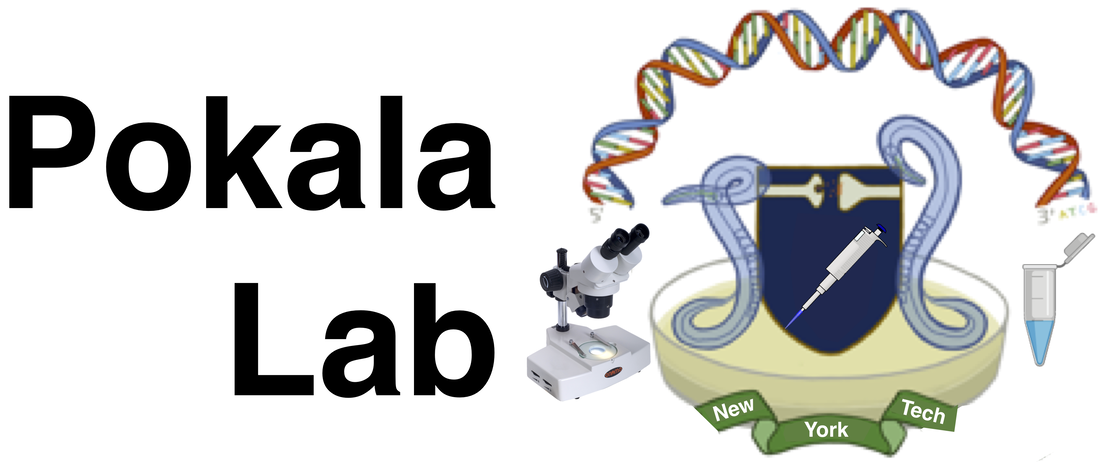Publications
Pokala N, Flavell SW. Recording and Quantifying C. elegans Behavior. Methods in Molecular Biology, 2468: 357–373 (2022) [PDF] [tracker_code]
López-Cruz A, Sordillo A, Pokala N, Liu Q, McGrath PT, Bargmann CI. Parallel multimodal circuits control an innate foraging behavior. Neuron. 102(2):407-41 (2019) [PDF]
Pokala N, Glater EE. Using optogenetics to understand neuronal mechanisms underlying behavior in C. elegans. Journal of Undergraduate Neuroscience Education. 16(2):A152-A158 (2018) [PDF]
Stout RF Jr, Pokala N. Neuroglia in C. elegans. Colloquium Series on Neuroglia in Biology and Medicine: From Physiology to Disease 5(1):1-56 (2018)
Wang H, Liu J, Gharib S, Chai CM, Schwarz EM, Pokala N, and Sternberg PW. cGAL, a temperature-robust GAL4-UAS system for Caenorhabditis elegans. Nature Methods 14(2): 145-148 (2017) [PDF]
Jin X, Pokala N, and Bargmann CI. Separate memory formation and retrieval circuits for aversive olfactory imprinting in C. elegans. Cell. Feb 11;164(4):632-643 (2016) [PDF]
Roberts WM, Augustine SB, Lawton KJ, Lindsay TH, Thiele TR, Izquierdo E, Faumont S, Andersen R, Britton MC, Pokala N, Bargmann CI, and Lockery SR. A stochastic neuronal flip-flop circuit regulates random search during foraging behavior. Elife. 2016;5:e12572 (2016) [PDF]
Gordus AG, Pokala N, Levy S, Flavell SW, and Bargmann CI. Feedback from network states generates variability in a probabilistic olfactory circuit. Cell. Apr 9;161(2):215-27 (2015) [PDF]
Calhoun AJ, Tong A, Pokala N, Fitzpatrick JA, Sharpee TO, Chalasani SH. Neural Mechanisms for Evaluating Environmental Variability in Caenorhabditis elegans. Neuron. Apr 22;86(2):428-41 (2015) [PDF]
Pokala N, Liu Q, Gordus A, Bargmann CI. Inducible and titratable silencing of Caenorhabditis elegans neurons in vivo with histamine-gated chloride channels. Proc Natl Acad Sci USA. Feb 18;111(7):2770-5 (2014) [PDF]
Flavell SW, Pokala N, Macosko EZ, Albrecht DR, Larsch J, Bargmann CI. Serotonin and the neuropeptide PDF initiate and extend opposing behavioral states in C elegans. Cell. Aug 29;154(5):1023-35 (2013) [PDF]
Garrison JL, Macosko EZ, Bernstein S, Pokala N, Albrecht DR, Bargmann CI. Oxytocin/vasopressin-related peptides have an ancient role in reproductive behavior. Science. Oct 26;338(6106):540-3 (2012) [PDF]
Schmitt C, Schultheis C, Pokala N, Husson SJ, Liewald JF, Bargmann CI, Gottschalk A. Specific expression of channelrhodopsin-2 in single neurons of Caenorhabditis elegans. PLoS One. 7(8):e43164. doi: 10.1371/journal.pone.0043164 (2012) [PDF]
Zimmer M, Gray JM, Pokala N, Chang AJ, Karow DS, Marletta MA, Hudson ML, Morton DB, Chronis N, Bargmann CI. Neurons detect increases and decreases in oxygen levels using distinct guanylate cyclases. Neuron. 61(6):865-79 (2009) [PDF]
Macosko EZ, Pokala N, Feinberg EH, Chalasani SH, Butcher RA, Clardy J, Bargmann CI. A hub-and-spoke circuit drives pheromone attraction and social behaviour in C elegans. Nature. 458(7242):1171-5 (2009) [PDF]
Chowdry AB, Reynolds KA, Hanes MS, Voorhies M, Pokala N, Handel TM. An object-oriented library for computational protein design. J Comput Chem. 28(14):2378-88 (2007) [PDF]
Pokala N, Handel TM. Energy functions for protein design II: adjustment with protein-protein complex affinities, models for the unfolded state, and negative design of solubility & specificity. J Mol Biol. 347(1): 203-227. (2005) [PDF] [EGAD_source_code]
Pokala N, Handel TM. Energy functions for protein design I: efficient and accurate continuum electrostatics and solvation. Protein Science. 13(4): 925-36. (2004) [PDF]
Pokala N, Handel TM. Protein design--where we were, where we are, where we're going. J Struct Biol. 134(2-3):269-81. (2001) [PDF]
Ayscough KR, Stryker J, Pokala N, Sanders M, Crews P, Drubin DG. High rates of actin filament turnover in budding yeast and roles for actin in establishment and maintenance of cell polarity revealed using the actin inhibitor latrunculin-A. J Cell Biol. 137(2):399-416. (1997) [PDF]
Goldsmith SC, Pokala N, Shen W, Fedorov AA, Matsudaira P, Almo SC. The structure of an actin-crosslinking domain from human fimbrin. Nat Struct Biol. 4(9):708-12. (1997) [PDF]
Goldsmith SC, Pokala N, Matsudaira P, Almo SC. Crystallization and preliminary crystallographic analysis of the N-terminal actin binding domain of human fimbrin. Proteins. 28(3):452-3. (1997) [PDF]
Lee GJ, Pokala N, Vierling E. Structure and in vitro molecular chaperone activity of cytosolic small heat shock proteins from pea. J Biol Chem. 270(18):10432-8. (1995) [PDF]
López-Cruz A, Sordillo A, Pokala N, Liu Q, McGrath PT, Bargmann CI. Parallel multimodal circuits control an innate foraging behavior. Neuron. 102(2):407-41 (2019) [PDF]
Pokala N, Glater EE. Using optogenetics to understand neuronal mechanisms underlying behavior in C. elegans. Journal of Undergraduate Neuroscience Education. 16(2):A152-A158 (2018) [PDF]
Stout RF Jr, Pokala N. Neuroglia in C. elegans. Colloquium Series on Neuroglia in Biology and Medicine: From Physiology to Disease 5(1):1-56 (2018)
Wang H, Liu J, Gharib S, Chai CM, Schwarz EM, Pokala N, and Sternberg PW. cGAL, a temperature-robust GAL4-UAS system for Caenorhabditis elegans. Nature Methods 14(2): 145-148 (2017) [PDF]
Jin X, Pokala N, and Bargmann CI. Separate memory formation and retrieval circuits for aversive olfactory imprinting in C. elegans. Cell. Feb 11;164(4):632-643 (2016) [PDF]
Roberts WM, Augustine SB, Lawton KJ, Lindsay TH, Thiele TR, Izquierdo E, Faumont S, Andersen R, Britton MC, Pokala N, Bargmann CI, and Lockery SR. A stochastic neuronal flip-flop circuit regulates random search during foraging behavior. Elife. 2016;5:e12572 (2016) [PDF]
Gordus AG, Pokala N, Levy S, Flavell SW, and Bargmann CI. Feedback from network states generates variability in a probabilistic olfactory circuit. Cell. Apr 9;161(2):215-27 (2015) [PDF]
Calhoun AJ, Tong A, Pokala N, Fitzpatrick JA, Sharpee TO, Chalasani SH. Neural Mechanisms for Evaluating Environmental Variability in Caenorhabditis elegans. Neuron. Apr 22;86(2):428-41 (2015) [PDF]
Pokala N, Liu Q, Gordus A, Bargmann CI. Inducible and titratable silencing of Caenorhabditis elegans neurons in vivo with histamine-gated chloride channels. Proc Natl Acad Sci USA. Feb 18;111(7):2770-5 (2014) [PDF]
Flavell SW, Pokala N, Macosko EZ, Albrecht DR, Larsch J, Bargmann CI. Serotonin and the neuropeptide PDF initiate and extend opposing behavioral states in C elegans. Cell. Aug 29;154(5):1023-35 (2013) [PDF]
Garrison JL, Macosko EZ, Bernstein S, Pokala N, Albrecht DR, Bargmann CI. Oxytocin/vasopressin-related peptides have an ancient role in reproductive behavior. Science. Oct 26;338(6106):540-3 (2012) [PDF]
Schmitt C, Schultheis C, Pokala N, Husson SJ, Liewald JF, Bargmann CI, Gottschalk A. Specific expression of channelrhodopsin-2 in single neurons of Caenorhabditis elegans. PLoS One. 7(8):e43164. doi: 10.1371/journal.pone.0043164 (2012) [PDF]
Zimmer M, Gray JM, Pokala N, Chang AJ, Karow DS, Marletta MA, Hudson ML, Morton DB, Chronis N, Bargmann CI. Neurons detect increases and decreases in oxygen levels using distinct guanylate cyclases. Neuron. 61(6):865-79 (2009) [PDF]
Macosko EZ, Pokala N, Feinberg EH, Chalasani SH, Butcher RA, Clardy J, Bargmann CI. A hub-and-spoke circuit drives pheromone attraction and social behaviour in C elegans. Nature. 458(7242):1171-5 (2009) [PDF]
Chowdry AB, Reynolds KA, Hanes MS, Voorhies M, Pokala N, Handel TM. An object-oriented library for computational protein design. J Comput Chem. 28(14):2378-88 (2007) [PDF]
Pokala N, Handel TM. Energy functions for protein design II: adjustment with protein-protein complex affinities, models for the unfolded state, and negative design of solubility & specificity. J Mol Biol. 347(1): 203-227. (2005) [PDF] [EGAD_source_code]
Pokala N, Handel TM. Energy functions for protein design I: efficient and accurate continuum electrostatics and solvation. Protein Science. 13(4): 925-36. (2004) [PDF]
Pokala N, Handel TM. Protein design--where we were, where we are, where we're going. J Struct Biol. 134(2-3):269-81. (2001) [PDF]
Ayscough KR, Stryker J, Pokala N, Sanders M, Crews P, Drubin DG. High rates of actin filament turnover in budding yeast and roles for actin in establishment and maintenance of cell polarity revealed using the actin inhibitor latrunculin-A. J Cell Biol. 137(2):399-416. (1997) [PDF]
Goldsmith SC, Pokala N, Shen W, Fedorov AA, Matsudaira P, Almo SC. The structure of an actin-crosslinking domain from human fimbrin. Nat Struct Biol. 4(9):708-12. (1997) [PDF]
Goldsmith SC, Pokala N, Matsudaira P, Almo SC. Crystallization and preliminary crystallographic analysis of the N-terminal actin binding domain of human fimbrin. Proteins. 28(3):452-3. (1997) [PDF]
Lee GJ, Pokala N, Vierling E. Structure and in vitro molecular chaperone activity of cytosolic small heat shock proteins from pea. J Biol Chem. 270(18):10432-8. (1995) [PDF]


